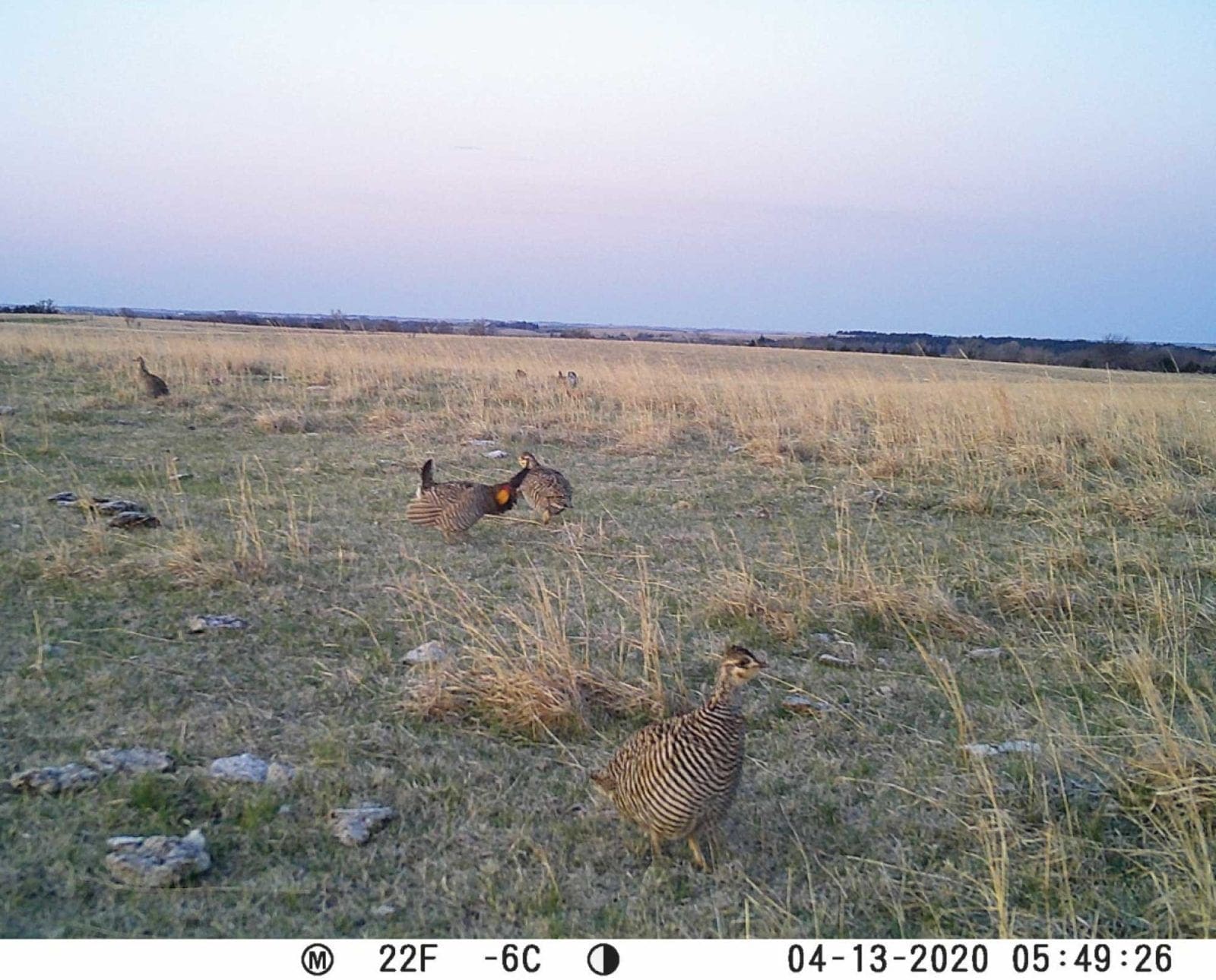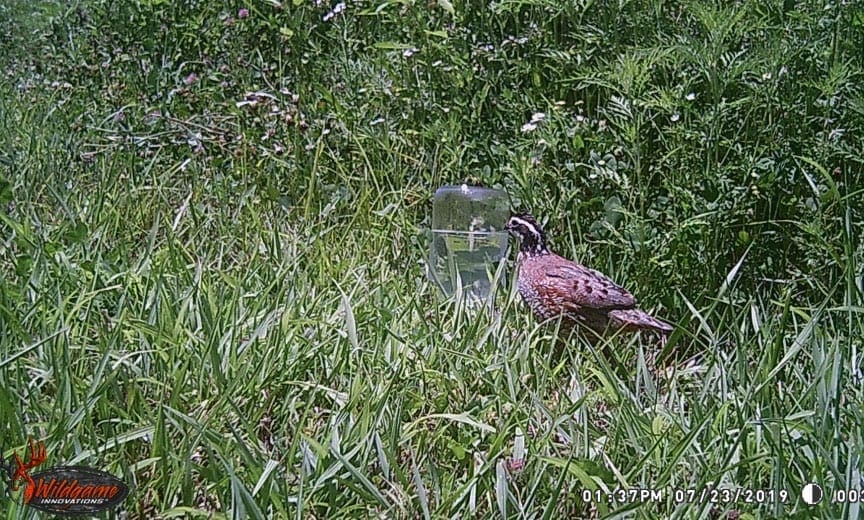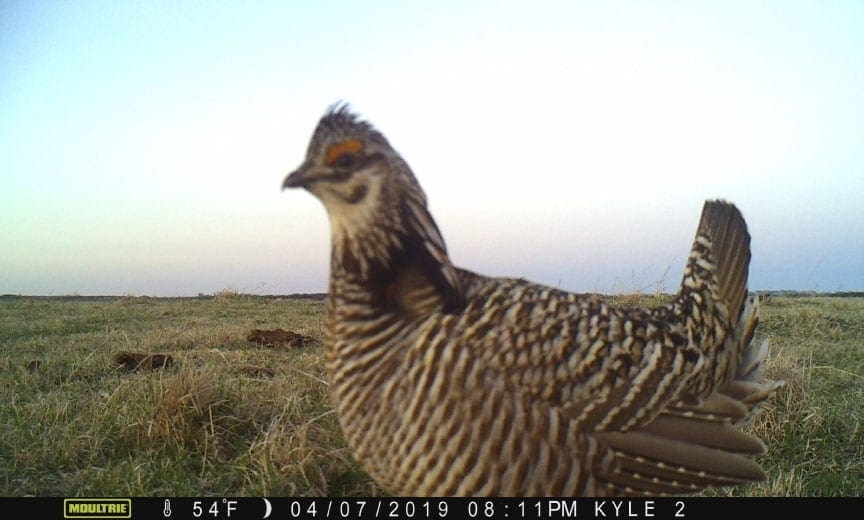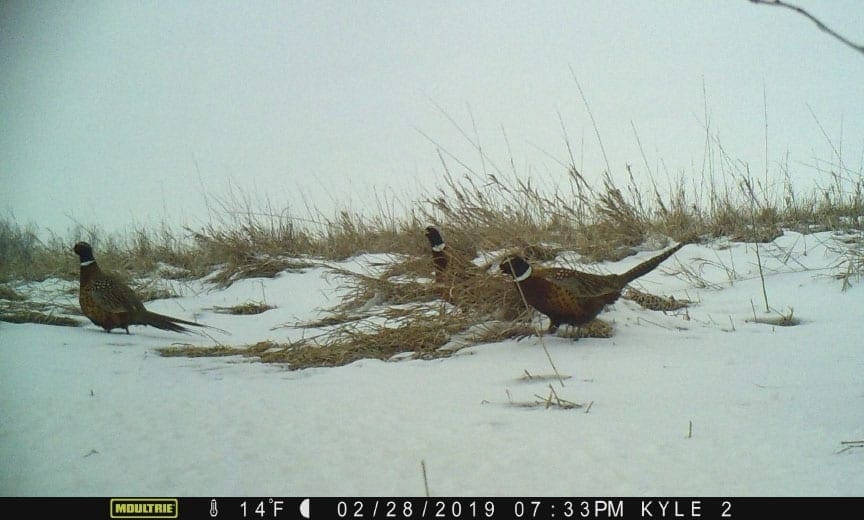Home » Hunting Gear » Scouting Upland Birds Using Trail Cameras
Scouting Upland Birds Using Trail Cameras

Kyle is an agronomist from Hiawatha, KS, a generalist hunter,…
How to use trail cameras to increase upland scouting efficiency.
It was Christmas morning, maybe not by the calendar date, but by the same sense of anxiousness the holiday brings of a surprise waiting to be discovered. The same feeling sets in every time I pull that small 1×1 inch card out of a digital game camera. The excitement of the endless possibilities that may be recorded on its memory, remind me of sneaking down the stairs to beat my siblings to the Christmas tree. All for the thrill of a peek at the carefully wrapped presents, to be unveiled later when the whole family was awake.
Holding an SD card in my hand, and rushing back to the pickup to view its contents, is like finally getting to open the gifts. This time was particularly exciting because I was trying something entirely new.
It was a frosty morning, and my pant legs were beginning to soak through with melted ice particles as I crawled among the thorns to reach a small post which held my camera. With my hands full of splinters and my face cut just under my eye from the briars, I began to wonder if this was all worth it. I had a meeting with a prospective seed corn customer in less than an hour, but knew I could fit in a quick memory card swap. In the distance, a rooster pheasant cackled, and I smiled knowing I most likely had caught a few photos of him. Nothing in my mind could make the added detour more worth it.
Saving Time with Trail Cameras
The idea of scouting with modern game cameras started one fall during college when an unexpected event triggered a need for a change of tactics. Earlier that same year, a heavy hailstorm had ravaged our prime opening morning pheasant field. The thick golden CRP grasses we were accustomed to hunting had been mowed to golf-course height by the storm. As we walked the field opening morning later that fall, there was no cover in sight, and the grim discovery of scattered feathers was all that remained of a once thriving pheasant population. We had obviously lost our main honey hole for the season. I suddenly found myself wishing I had done some pre-season scouting.
Several months later, I was scrolling through an SD card I pulled from a favorite deer pinch-point and realized I had plenty of summer whitetail deer scouting images filling up my computer memory. I pretty well knew the patterns of the deer on the farms I hunted, and collecting pictures of them became monotonous. One thing I did realize was the amount of scouting time these cameras had saved me while balancing my daily schedule with chasing bucks. Back then, time was becoming a commodity, and it has only become more limited since.
READ: Scouting Turkeys with Trail Cameras
In an effort to be most efficient with my time, I began the idea of scouting for upland birds using the same game cameras I had been using for deer. Not only did this provide a thrilling new hobby, but it has proven to be a practical scouting technique. This has been a real game changer in not only gaining new areas but being more efficient with selecting hunting spots come fall. Even better, setting up and checking cameras has become a fun event for the whole family as anyone can do this, regardless of age or skill.
How to Supplement Your Scouting Information with Trail Cameras
When using OnX or a state atlas to narrow down a few new likely locations for bird habitat, we all hit a point when you need to physically check an area out and judge its potential. It’s at this point that I reach for a game camera. Most of the time, I have a rough idea where I’m going to place my set (more on this later).
Traveling to the field just once or twice is the only real investment after this. In just a few minutes, I can set each camera and leave it as long as needed to cover 24/7 surveillance of the chosen area. There’s really no replacement for this photo data, especially since most of us can’t afford the time it takes to drive regularly to our hunting spots, let alone walk them looking for birds ahead of season.
Game cameras work as the last “boots on the ground” step in pre-season scouting. Nothing beats photo evidence when it comes to proving if a field actually holds game. I physically check my digital scouting theories by setting up camera locations weeks ahead of season. This isn’t just limited to finding new fields, but also gaining more knowledge of the species you’re after. How many of us really know the daily habits of birds we hunt, even within our old reliable honey-holes? Who has actually sat and observed their movements for a whole day? How many of us have the time to do any of this? With game cameras, all you need is a few hours.
How to Set Up a Trail Camera for Upland Birds
Setting a camera for a bird requires different technique than just strapping it to a tree like you’d typically do near a deer trail. For camera placement with upland birds, I use custom stands I fabricated from old seed sign posts. These three foot tall posts have a large spade on the bottom, and when driven in the ground eight inches or so, have about an eight inch tall ledge to set a camera on. When photographing in more open areas, this is by far the best technique as it puts the camera angle right at the birds eye level.
If the cover happens to be thick and tall, I simply mount the camera on a flat ledge of angle iron welded to the top of these posts to provide a taller vantage. In today’s market, commercial versions of a similar idea are readily available at sporting goods stores. One major tip regardless of the cover is to always face your camera northward when possible. If simply scouting, this usually guarantees that the sun is behind the camera and you’ll always be able to see what’s in the photo. On the other hand, I’ve placed a camera directly facing a sunrise or sunset purposely to catch the silhouette of prairie chickens or pheasants against a painted sky. With practice, your photos can become more than just evidence of game.
Where to Set Up a Trail Camera for Upland Birds
Camera placement can vary with species, but for most of the upland birds here in Kansas, each spot can provide a mixed bag of photos. When it comes to upland habitat, a bird is a bird, at least to some extent. They all need the same basic things: food, cover, and space.
Target Travel Corridors
Because of this, travel corridors are my main hot spots. Plum thickets, hedge rows, field waterways, and field edges are prime locations. You can capture any species of game bird traveling along these areas and confirm their presence on a property. These travel areas also tend to allow you to catch pictures of multiple birds walking to feed together or in consecutive photos. This is the quickest and best way to identify if a particular farm holds the quarry you’re after.
Target Food Sources
Food sources are a close second in my favorite locations to catch photos. Don’t overlook the idea of food plots, bait sites, grain fields, or other sources of food when scouting for birds. It may feel like cheating, but spilled corn on the edge of a field is the best place to get a solid count on a covey of bobwhite quail. I often use this technique to determine if a covey is large enough to pursue and how many birds I might be comfortable with harvesting that particular season.

Whenever I find a single feather among a food source, I know a good amount of pictures can be captured in that exact spot. Water can also be lumped into this category. While morning dew provides nourishment for most upland birds, pond edges and puddles can provide excellent photos. I keep a small chicken waterer at the edge of our lawn each summer and catch many pictures of quail enjoying a free drink.
Target Roosts and Nesting Areas
Roosts/nesting areas are more difficult, but are an effective place to set a camera. These areas have provided by far the best first-light starting points on opening morning. I have many pictures of pheasants coming and going from roosts once I had narrowed down the protected hillsides they were using. While pheasant roost sites can be found easily and provide great pictures, I have yet to catch bobwhites in their roost on camera. My goal has always been to catch a shot of the “roost circle” that quail like to sleep in. I have also always thought nesting sites would make great photos, but have never felt comfortable with potentially disturbing the nesting process. Ethics play a part in all aspects of hunting, especially when combining modern technologies with old tradition.

Focus on Leks
One of the coolest areas I’ve found to place scouting cameras are leks/breeding areas (which is only relevant to certain species). My favorite experience yet is finding a greater prairie chicken covey on their booming grounds in the spring. Simply wanting to find them and hoping for at least one picture confirming a chicken, I got lucky and set up exactly where I needed to get 1800 pictures of the mating dances of prairie chickens on my first time trying.
The photos of booming male chickens taught me things that have helped when trying to locate them in the fall. This isn’t only limited to lekking birds. While sitting with my wife in a blind witnessing this exact prairie chicken covey booming one morning, we could hear bobwhites whistling, pheasants crowing, and turkeys gobbling. You can be sure that those birds also use the same general farms, even if not quite as regular as the chickens do.
WATCH: Sacred Lek – A Prairie Dance Story
The Unusual Things We can Learn from Scouting Upland Birds with Trail Cameras
This brings me to another important point. My experience is limited to the birds of Kansas. This same technique can be applied to Arizona quail, mountain grouse, drumming logs of the north, and even waterfowl. No matter what the quarry is, we can all agree–more time scouting means more experiences come fall. If nothing else, these small cameras provide an additional hobby and rewarding experience. More than just locating birds, I have learned so much since converting my old deer cameras to upland scouting machines.

For example, pheasants can be patterned like clockwork walking from cover to food, even more so than deer. Quail are very sporadic and may feed in an area for a few days only to disappear for a few weeks before checking out the food source again. Prairie chickens don’t mind cattle, but almost every other animal will spook them if approached. They will, however, almost always return 25-30 minutes later to exactly the same spot they were flushed from.
All game birds, follow a rough daily schedule of feeding early and late while loafing mid-day. I have found, though, that this is just a general idea. Pheasants will feed just as readily late morning or early afternoon. Pheasants and chickens spend time in groups of similar sex, while quail almost always appear as a 1:1 male to female ratio. In addition to upland game, ducks, badgers, bobcats, and all other species inhabit the same areas as our beloved game birds. They will eat just as much memory card space as your birds and keep things interesting. It’s always an adventure checking a full memory card, and it can yield some photos worthy of framing on a wall.
Choosing a Trail Camera
Today’s technology is greatly improving and these cameras can be had for less than $100 in most cases. If you’re looking to get into using these cameras for the sole purpose of scouting, there are a few cameras that cost around $40 and they work great. For the person concerned about photo quality, the phrase “you get what you pay for” certainly applies. It goes without saying that your investment is placed at risk when scouting on public lands (check your local laws before using these on public areas), but fortunately most will walk by a plum thicket or CRP field and never notice the camera pointed their way.
Upland scouting simply lends itself to more overlooked areas than the typical deer hunting site. The largest risk is simply placing a camera and returning to find no pictures on it. In this case, simply pack up and move the camera a few hundred yards, or onto the next spot. The real fun is in the challenge of finding them anyway. Regardless of the risks, if you’re ever in Kansas and see someone on hands and knees in the briars of a Walk-in Hunting Area, you just may have found one of my favorite quail covers. Whether you choose to move on, or place a camera right near mine, I hope you give this scouting method a try.
SUBSCRIBE to the AUDIO VERSION brought to us by: ESP – Digital Hearing Protection for FREE : Google | Apple | Spotify
Kyle is an agronomist from Hiawatha, KS, a generalist hunter, but specifically; upland bird hunter, fur trapper, and fisherman. He enjoys doing anything that keeps him outdoors with his wife Shelby, son Cash, and lab Jack.





Kyle…what a GREAT article! You and I have discussed the use of game cameras when we first met and obviously through your story in the PU Magazine Summer Issue, but I had no idea as to the benefits of game cameras. Very well written. I hope to see a follow up piece on this topic and / or one on waterfowl.
Interesting article but I have a concern about the use of modern technology to monitor and assist the harvest of wild game. At what point does the technology replace or infringe on the notion of “fair chase”? Given the limited resource out there and pressures already on habitat and wildlife populations, is it really wise to bring to bear our human intellect and technology to give us an advantage harvesting game. I know you’re just scouting and that the device does not help you to harvest the birds but it gives you a distinct advantage hunters have not previously enjoyed. So imagine the next phase of technological development, which is likely already available or will be soon, where the camera transmits the images to your phone in real time while you’re sitting in your truck and you then drive down the road to the occupied field, go out, hunt that field and harvest a limit. You might not do that, but you know others will. Raises lots of interesting ethical questions in my mind. What are the limits? What is legal? Can you look at images and hunt on the same day? Can we enforce reasonable regulations or are we opening up Pandora’s Box? For me personally, my bias is in favor of old-fashioned traditional hunting where you scout, use your well-earned knowledge and experience, and work to find your birds. As an aside, I’m also not in favor of Mojos and other electronically activated devices for duck hunting. I think the resource is limited and we need to give the game we hunt our respect and as much advantage as we can. Don’t get me wrong, I’m not condemning you for using game cameras and I realize that I’m probably in the minority on this, but would be eager to hear the respectful opinions of others.
Great points and discussion John. The rapid advancement of technology is (and will) raise a lot of questions as it relates to hunting. Both ethical and legal I am sure. The upland tradition makes it even more glaring as many of us still carry double guns designed 100 years ago and dogs that are a fruition of visions from the greats before. And much like fly fishing, our culture has been built on the idea of art and difficulty as part of the allure. Its a lot easier to ground swipe a partridge than to wingshoot a ruffed grouse over a pointing dog that you have trained. Certainly part of the evolution (myself included). I have heard some debate in the deer hunting world about trail cameras that send pictures to cell phones and laws being passed to prevent killing that animal in the same day. Mark Parman wrote a recent article on here called “Should New Technology Have a Place in Upland Hunting” It brings up other aspects that have evolved our culture as well like the rise of social media. We can probably all agree that social media has been a double edged sword raising many questions about how culture evolves and with it potentially the ethics that create it. Great input, thank you.
I’ve got a get idea. Let’s get a frontal lobotomy to cut out the intellectual advantage then cut out all technology and just use rocks. That would be real fair chase😂
I appreciate the comments. I have wrestled with ethics using trail cameras throughout my time owning and using them. In some ways, that may be why I now use them much less when deer hunting. I found myself more worried about what the camera showed, than actually learning the habitat and habits of the deer. It was also way too easy to get caught up in the “big buck only” game. Now I just go enjoy the hunt, and take the animal that shows when I’m ready. It has brought back the traditional surprise of never knowing what will step out.
I am completely against cellular cameras and feel that I need to put the work in to physically get outdoors to retrieve the pictures. I won’t claim that anyone is wrong by using them, but it’s not for me. Also, I usually don’t run these cameras during any open season. Mainly to avoid theft. I have however, been alerted by our wireless Ring video doorbell about a coyote about to carry our cat off of our porch and was happy to have the technology in that case.
Ethics are a tricky thing, and everyone varies in their belief. As mentioned in the article, there are times I will pass on hunting a covey I feel is too small. Without the cameras, we would have usually went in, flushed and shot. Only to wonder later if we reduced the covey to an unsustainable count for the area.
One day, I might decide to stop the use of trail cameras in the Uplands to get back to a more traditional scouting approach. For now, I’m having way too much fun gaining really unique photos that almost all of us wouldn’t get to see without this technology